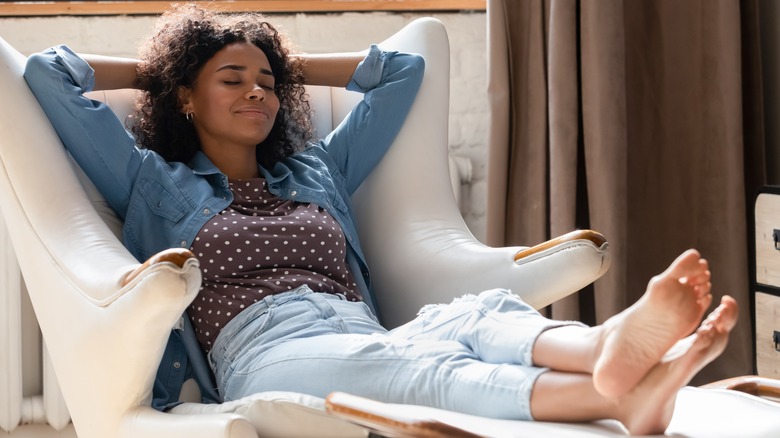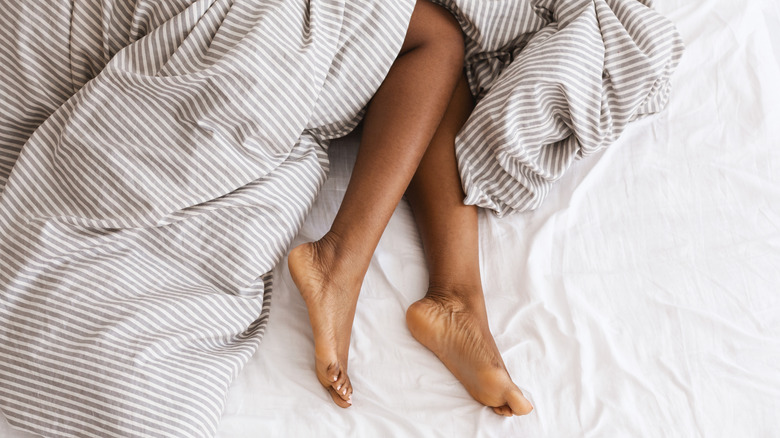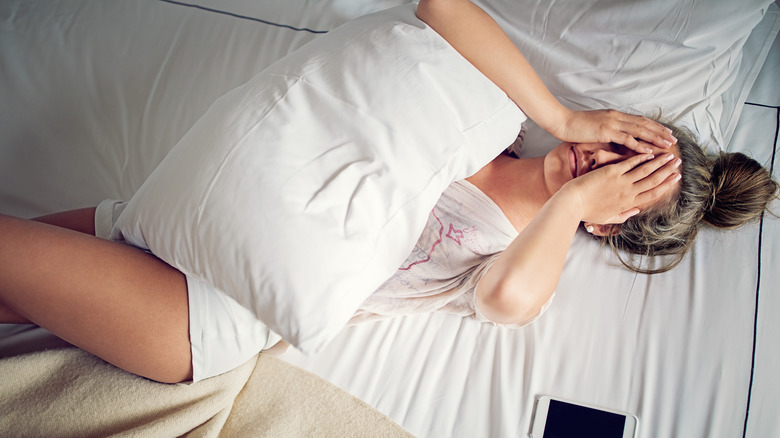Why 'Cricket Feet' Helps You Fall Asleep
Sometimes, TikTok introduces us to a genius hack we've never thought of. Other times, the social media platform gives a name to something we've done forever. Depending on your bedtime routine, "cricket feet" might fall into either category. The term has earned a whopping 72 billion views on TikTok, and spoiler: It has nothing to do with insects. Instead, cricket feet (or "cricketing") is a soothing pre-snooze habit where you rub your feet together, kind of like how crickets rub their wings together to make a chirping sound.
Some content creators say they cricket any time they lie down, but a common theme is cricketing in bed to drift off to sleep. "I CANNOT fall asleep without doing cricket feet," TikTok user Rachel Lovitt wrote in a video caption. If you can relate, it might be because cricketing is thought to relax the body. "'Cricket feet' are perhaps a form of stimming [self-stimulating behaviors], thus assisting in pre-sleep relaxation," Michelle Di Paolo, founder, and psychotherapist for Stress and Relaxation Services of America, explained to Sleepopolis. Di Paolo adds that rubbing your feet together may have a similar effect to rubbing or blowing into your hands, which helps to warm and soothe the body — and that might be just what you need to wind down after a stressful day.
Why is cricketing so relaxing?
Cricket feet can be a comforting bedtime ritual, but what makes the practice feel so nice? According to Dr. Eileen Li, a licensed acupuncturist, Chinese herbalist, and physical therapist practicing at Anew Integrative Acupuncture, cricketing may mimic the benefits of getting a foot massage. Specifically, Li told Bustle that rubbing your tootsies together stimulates two pressure points that help chill you out: LV3, located on the top of the feet between the first and second toes, and KD1, located on the bottom of the feet between the second and third toes. The acupuncture expert also noted that there are plenty of pleasurable nerve endings on the feet, which might explain why you can't help but cricket when lying on the sofa or in bed.
Cricketing can also impact the body in similar ways to other repetitive behaviors. "Some evidence suggests that repetitive motions can stimulate the release of feel-good neurotransmitters [like oxytocin] and endorphins, which are natural painkillers produced by the body," Dr. Lauren Kerwin, a clinical psychologist, revealed to Well+Good. As a result, you might notice yourself doing cricket feet more frequently when overwhelmed, especially if daily stressors are getting in the way of catching ZZZs.
Cricketing can sometimes point to another condition
When the lights go out, anyone can become a "cricket," rubbing their feet together until finally dozing off. However, the habit — and other forms of repetitive stimming — are often related to neurodivergent conditions, as medical expert Dr. Mike Bohl shared with Eat This, Not That!. According to Healthline, stimming is a hallmark of autism and is often used to cope with sensory discomfort or difficult emotions. With cricket feet in particular, Dr. Lauren Kerwin told Well+Good, "Those who cricket while they fall asleep, which is common, do so often to improve their sensory processing of their body lying down."
Given the habit's ability to relieve stress, compulsive cricketing could also indicate anxiety or another mental health condition. However, rubbing your feet likely won't be the only symptom you'll notice. Mood fluctuations, lack of interest, trouble concentrating, and other emotional and behavioral changes are common signs of mental health disorders, as per Mayo Clinic.
Finally, cricket feet could be caused by a physical health condition. "[I]f you find the movement bothersome and can't seem to control your urge to do it, you may have a different issue going on, such as restless leg syndrome," Dr. Bohl disclosed to Eat This, Not That!. Even if you usually fall asleep after doing cricket feet, it's wise to mention the habit to your doctor to rule out an underlying medical issue.


